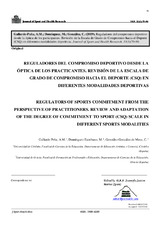Mostrar el registro sencillo del ítem
Reguladores del compromiso deportivo desde la óptica de los practicantes. Revisión de la escala de grado de compromiso hacia el deporte (csq) en diferentes modalidades deportivas
| dc.contributor.author | Gallardo Peña, Antonio Manuel | |
| dc.contributor.author | Domínguez Escribano, Marta | |
| dc.contributor.author | González González de Mesa, C. | |
| dc.date.accessioned | 2019-05-13T10:50:14Z | |
| dc.date.available | 2019-05-13T10:50:14Z | |
| dc.date.issued | 2019 | |
| dc.identifier.uri | http://hdl.handle.net/10396/18541 | |
| dc.description.abstract | El objetivo de este estudio ha sido comprobar las diferencias en el compromiso deportivo entre grupos de deportistas cuyas modalidades de práctica difieren en cuanto la interacción con los adversarios, y si para ello se puede aplicar con garantía de éxito la Escala de Grado de Compromiso hacia el Deporte (CSQ). Se ha comenzado realizando un análisis factorial sobre CSQ, y un MANOVA 2x4 (sexo x edades) para comprobar el efecto de estas variables en el compromiso deportivo. Han participado 472 deportistas, 49.8% varones y 50.2% mujeres. Los resultados evidencian la estructura bifactorial (compromiso actual y compromiso futuro) de la escala planteada por Orlick (2004) y validada en el contexto español con futbolistas adolescentes por Belando, Ferriz-Morell, y Moreno-Murcia (2012). Se ha comprobado que las horas de entrenamiento y la edad de los deportistas influye en el compromiso hacia el deporte, sin embargo, el sexo y la modalidad deportiva no es en ningún caso determinante. | es_ES |
| dc.description.abstract | The objective of this study was to verify the differences that may exist in the sports commitment between groups of athletes whose practice modalities differ in the presence, or not, of interaction with opponents and if this can be applied with guarantee of success the Degree of Commitment to Sports (CSQ) Scale. A factorial analysis of CSQ has begun, followed by a MANOVA 2x4 (sex x ages) to verify the effect of these variables on sports commitment. 472 athletes participated, 49.8% males and 50.2% females. The results showed the bifactorial structure (current commitment and future commitment) of the scale proposed by Orlick (2004) and validated in the Spanish context with adolescent soccer players by Belando, Ferriz-Morell, and Moreno-Murcia (2012). It has been verified that the hours of training and the age of the athletes influences the commitment to the sport, however the sex and the sport modality is not in any case determinant. | es_ES |
| dc.format.mimetype | application/pdf | es_ES |
| dc.language.iso | spa | es_ES |
| dc.publisher | Asociación Didáctica Andalucía (D.A.A.) | es_ES |
| dc.rights | https://creativecommons.org/licenses/by-nc-nd/4.0/ | es_ES |
| dc.source | Journal of sport and health research 11, (1), 79-90 (2019) | es_ES |
| dc.subject | CSQ | es_ES |
| dc.subject | Compromiso deportivo | es_ES |
| dc.subject | Deportes de contacto | es_ES |
| dc.subject | Deportes sin contacto | es_ES |
| dc.subject | Tiempo de práctica deportiva | es_ES |
| dc.subject | Análisis factorial | es_ES |
| dc.subject | Sports commitment | es_ES |
| dc.subject | Contact sports | es_ES |
| dc.subject | Sports without contact | es_ES |
| dc.subject | Sports practice time | es_ES |
| dc.subject | Factorial analysis | es_ES |
| dc.title | Reguladores del compromiso deportivo desde la óptica de los practicantes. Revisión de la escala de grado de compromiso hacia el deporte (csq) en diferentes modalidades deportivas | es_ES |
| dc.title.alternative | Regulators of sports commitment from the perspective of practitioners. Review and adaptation of the degree of commitment to sport (csq) scale in different sports modalities | es_ES |
| dc.type | info:eu-repo/semantics/article | es_ES |
| dc.relation.publisherversion | http://www.journalshr.com/papers/Vol%2011_N%201/JSHR%20V11_1_7.pdf | es_ES |
| dc.rights.accessRights | info:eu-repo/semantics/openAccess | es_ES |

